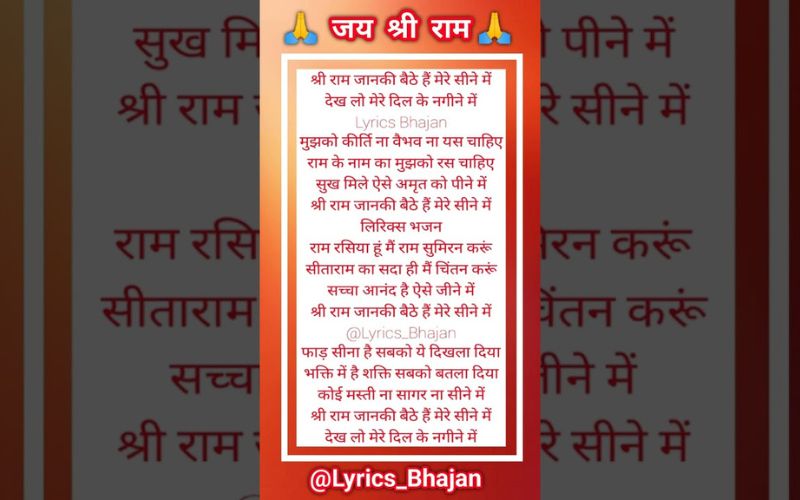“Shri Ram Janki Baithe Hai Mere Seene Mein” is a deeply devotional and spiritually uplifting song that has captured the hearts of millions of devotees across India and the world. This timeless bhajan, or Hindu devotional song, celebrates the divine presence of Lord Ram and his beloved consort, Sita, within the devotee’s own heart and soul. The lyrics of this powerful composition convey a profound sense of devotion, surrender, and the experience of the divine residing within.
The song’s title, which translates to “Shri Ram and Janki (Sita) reside in my heart,” reflects the core essence of the lyrics. Through this bhajan, the devotee expresses their deep yearning to feel the constant presence of the divine couple, Sri Ram and Sita, within their own being. The lyrics invite the listener to embark on a spiritual journey, where the devotee’s heart becomes the sacred abode for the manifestation of the divine.
Meaning and significance of the lyrics
The lyrics of “Shri Ram Janki Baithe Hai Mere Seene Mein” are rich in spiritual symbolism and profound meaning. Each line of the song carries a deep significance, conveying the devotee’s unwavering faith, devotion, and the experience of the divine within.
- Shri Ram Janki Baithe Hai Mere Seene Mein:
- This opening line establishes the central theme of the song, which is the devotee’s firm belief that Lord Ram and Sita reside within their own heart and being.
- The use of the word “Baithe” (seated) suggests a sense of permanence and stability, implying that the divine couple have made the devotee’s heart their eternal abode.
- Sada Sada Rahen Mere Seene Mein:
- This line reinforces the idea that the divine presence is a constant and eternal phenomenon, not just a fleeting experience.
- The repetition of “Sada Sada” (always, forever) emphasizes the devotee’s unwavering conviction in the continuous divine presence within.
- Mera Dil Unka Hai, Unka Hai Mera Dil:
- This line expresses the devotee’s complete surrender and identification with the divine.
- The reciprocal ownership expressed in “Mera Dil Unka Hai, Unka Hai Mera Dil” (My heart is theirs, their heart is mine) signifies the devotee’s total submission and the merging of the individual self with the divine.
- Shri Ram Janki Baithe Hai Mere Seene Mein:
- The repetition of the opening line reinforces the central theme and the devotee’s unwavering belief in the divine presence within.
Through these powerful lyrics, the devotee expresses their deep longing to experience the divine within, to feel the constant presence of Lord Ram and Sita, and to ultimately attain a state of oneness with the divine.
Historical background of the song
“Shri Ram Janki Baithe Hai Mere Seene Mein” is a timeless devotional song that has its roots in the rich cultural and spiritual heritage of India. The song is believed to have originated from the devotional tradition of Hinduism, specifically the Vaishnava sect, which is centered around the worship of Lord Vishnu and his various incarnations, including Lord Ram.
The song’s composition is often attributed to the revered saint-poet Tulsidas, who is renowned for his magnum opus, the “Ramcharitmanas,” a celebrated retelling of the epic Ramayana in the Awadhi language. Tulsidas, a devotee of Lord Ram, is believed to have composed this bhajan as a means of expressing his profound love and devotion for the divine couple, Sri Ram and Sita.
The song’s enduring popularity and widespread appeal can be traced back to the 16th century, when Tulsidas’ writings and compositions gained immense popularity among the masses. The bhajan has since been passed down through generations, with various regional and cultural adaptations emerging over time, yet the core essence and spiritual significance have remained intact.
Popular renditions and versions of the song
“Shri Ram Janki Baithe Hai Mere Seene Mein” has been performed and recorded by numerous renowned artists and devotional singers across India. Each rendition brings a unique interpretation and flavor to the timeless composition, showcasing the versatility and adaptability of the song.
Some of the most notable and popular versions of the bhajan include:
- Classical Renditions:
- Pandit Bhimsen Joshi’s soulful and deeply emotive rendition, which captures the essence of classical Indian music.
- Pt. Hariprasad Chaurasia’s mesmerizing flute interpretation, which seamlessly blends the divine melody with the spiritual essence of the lyrics.
- Devotional Interpretations:
- Lata Mangeshkar’s rendition, which showcases her unparalleled vocal prowess and the depth of her devotion.
- Anuradha Paudwal’s version, which resonates with the listeners through its powerful and devotional delivery.
- Folk and Regional Adaptations:
- Versions in various regional languages, such as Gujarati, Marathi, and Bengali, reflecting the song’s pan-Indian appeal.
- Folk adaptations that incorporate local musical styles and instruments, further enriching the cultural tapestry of the bhajan.
These diverse renditions have contributed to the song’s enduring popularity and its ability to transcend linguistic and cultural boundaries, appealing to devotees across India and the world.
Analysis of the lyrics and their spiritual essence
The lyrics of “Shri Ram Janki Baithe Hai Mere Seene Mein” are imbued with profound spiritual significance, offering a glimpse into the devotee’s journey of devotion and the experience of the divine within.
- The Concept of the Divine Couple:
- The lyrics highlight the concept of the divine couple, Sri Ram and Sita, as the embodiment of the divine. This representation of the divine in the form of a couple symbolizes the union of the masculine and feminine principles, the divine and the human, and the ultimate state of wholeness and harmony.
- The Heart as the Abode of the Divine:
- The repeated emphasis on the devotee’s heart as the seat of the divine presence reflects the Hindu belief that the divine resides within the individual. The heart is seen as the sacred space where the devotee can commune with the divine and experience their eternal presence.
- Devotion and Surrender:
- The lyrics express the devotee’s unwavering devotion and complete surrender to the divine. The reciprocal ownership between the devotee and the divine, as seen in the line “Mera Dil Unka Hai, Unka Hai Mera Dil,” signifies the devotee’s desire to merge their individual identity with the divine.
- Eternal and Constant Presence:
- The repetition of the phrase “Sada Sada” (always, forever) emphasizes the devotee’s belief in the eternal and constant presence of the divine within their heart. This conveys the idea of the divine as a permanent and uninterrupted reality, rather than a fleeting experience.
- Spiritual Transformation and Oneness:
- The lyrics suggest a profound spiritual transformation, where the devotee aspires to transcend the individual self and attain a state of oneness with the divine. This process of merging with the divine is a central theme in Hindu spirituality and devotional practices.
Through the analysis of the lyrics, we can discern the deep spiritual essence and the devotee’s yearning to experience the divine presence within their own being, ultimately seeking to achieve a state of unity with the divine.
Cultural impact and popularity of the song
“Shri Ram Janki Baithe Hai Mere Seene Mein” has transcended the boundaries of its religious and cultural origins to become a beloved and widely recognized devotional song across India and beyond. The song’s enduring popularity and cultural impact can be attributed to several factors:
- Universality of the Devotional Sentiment:
- The song’s central theme of devotion, surrender, and the experience of the divine within the human heart resonates with devotees of various religious and cultural backgrounds. This universality has allowed the song to be embraced by a diverse audience, cutting across linguistic and regional divides.
- Spiritual Significance and Emotional Appeal:
- The profound spiritual significance and the emotional depth conveyed through the lyrics have struck a chord with millions of devotees. The song’s ability to evoke a sense of devotion, comfort, and inner peace has contributed to its widespread popularity.
- Adaptability and Versatility:
- The song’s adaptability to various musical styles and renditions, as mentioned earlier, has further enhanced its appeal and allowed it to be embraced by diverse communities and traditions. This versatility has ensured the song’s longevity and its ability to remain relevant across generations.
- Association with the Ramayana Epic:
- The song’s connection to the revered Ramayana epic, through its reference to Lord Ram and Sita, has strengthened its cultural significance and resonance among devotees of the Vaishnava tradition and the broader Hindu community.
- Devotional Practices and Rituals:
- The song has become an integral part of various devotional practices, rituals, and celebrations within the Hindu faith. Its inclusion in religious ceremonies, temple performances, and personal devotions has further solidified its cultural impact and significance.
The cultural impact and widespread popularity of “Shri Ram Janki Baithe Hai Mere Seene Mein” have transcended its religious origins, making it a beloved and cherished devotional song that continues to inspire and uplift devotees across generations and regions.
Translating the lyrics: English interpretation of “Shri Ram Janki Baithe Hai Mere Seene Mein”
Here is an English translation of the lyrics of “Shri Ram Janki Baithe Hai Mere Seene Mein”:
- Shri Ram Janki Baithe Hai Mere Seene Mein:
- Lord Ram and Sita reside in my heart.
- Sada Sada Rahen Mere Seene Mein:
- They remain forever, always in my heart.
- Mera Dil Unka Hai, Unka Hai Mera Dil:
- My heart is theirs, their heart is mine.
- Shri Ram Janki Baithe Hai Mere Seene Mein:
- Lord Ram and Sita reside in my heart.
The English translation captures the essence of the lyrics, conveying the devotee’s belief in the constant presence of the divine couple, Sri Ram and Sita, within their own being. The translation highlights the themes of devotion, surrender, and the experience of the divine residing in the devotee’s heart.
How to sing and perform the song
Singing and performing “Shri Ram Janki Baithe Hai Mere Seene Mein” can be a deeply rewarding and spiritual experience for both the performer and the audience. Here are some tips to help you sing and perform this devotional classic:
- Understand the Meaning and Significance:
- Begin by thoroughly understanding the meaning and spiritual significance of the lyrics. This will help you connect with the deeper essence of the song and convey it effectively through your performance.
- Adopt a Devotional Mindset:
- Approach the performance with a devotional mindset, focusing on the divine presence and your own personal connection with the divine. This will help you infuse your rendition with genuine emotion and devotion.
- Explore Different Musical Styles:
- Experiment with various musical styles, such as classical, folk, or contemporary, to find the one that resonates with you and your audience. This will allow you to showcase the versatility of the song.
- Emphasize the Spiritual Essence:
- Emphasize the spiritual essence of the lyrics through your vocal expression, phrasing, and interpretative choices. This will help the audience connect with the deeper meaning and the devotional spirit of the song.
- Engage the Audience:
- Involve the audience in the performance by encouraging them to sing along or participate in the chorus. This will create a shared experience of devotion and spiritual connection.
- Practice and Refine Your Rendition:
- Continuously practice and refine your rendition of the song, paying attention to your vocal technique, phrasing, and emotional expression. This will help you deliver a polished and impactful performance.
By following these tips, you can create a captivating and spiritually uplifting performance of “Shri Ram Janki Baithe Hai Mere Seene Mein” that will resonate with your audience and deepen their connection with the divine.
Related devotional songs and bhajans
“Shri Ram Janki Baithe Hai Mere Seene Mein” is part of a rich tapestry of devotional songs and bhajans that celebrate the divine presence and the devotee’s relationship with the divine. Here are some related devotional songs and bhajans that you may find interesting:
- “Raghupati Raghav Raja Ram”:
- This classic devotional song, also composed by Tulsidas, pays homage to Lord Ram and his divine attributes.
- “Jai Jai Ram Jai Jai Ram”:
- A popular chant that glorifies the name of Lord Ram and invokes his blessings.
- “Hanuman Chalisa”:
- A revered devotional hymn that praises the virtues and divine powers of Lord Hanuman, the devoted servant of Lord Ram.
- “Govardhan Giriraj Ki Jai”:
- A devotional song that celebrates Lord Krishna’s protection of the people of Vrindavan by lifting the Govardhan Hill.
- “Jai Jagdish Hare”:
- A widely sung devotional song that invokes the divine presence of Lord Vishnu, the preserver of the universe.
Exploring these and other related devotional songs and bhajans can deepen your understanding and appreciation of the rich spiritual and cultural heritage that “Shri Ram Janki Baithe Hai Mere Seene Mein” is a part of.
Conclusion
“Shri Ram Janki Baithe Hai Mere Seene Mein” is a timeless devotional gem that has captured the hearts and souls of countless devotees across India and the world. Through its powerful lyrics, the song invites the listener to embark on a spiritual journey, where the divine presence of Lord Ram and Sita is experienced within the devotee’s own heart and being.
The song’s enduring popularity, its adaptability to diverse musical styles, and its profound spiritual significance have all contributed to its enduring cultural impact. As you explore and engage with this devotional classic, may you be inspired to deepen your own spiritual connection and experience the divine residing within you.
To further deepen your understanding and appreciation of “Shri Ram Janki Baithe Hai Mere Seene Mein,” we invite you to explore other related devotional songs and bhajans that celebrate the divine presence and the devotee’s relationship with the divine. Engage with these timeless compositions and let them guide you on your own spiritual journey.





